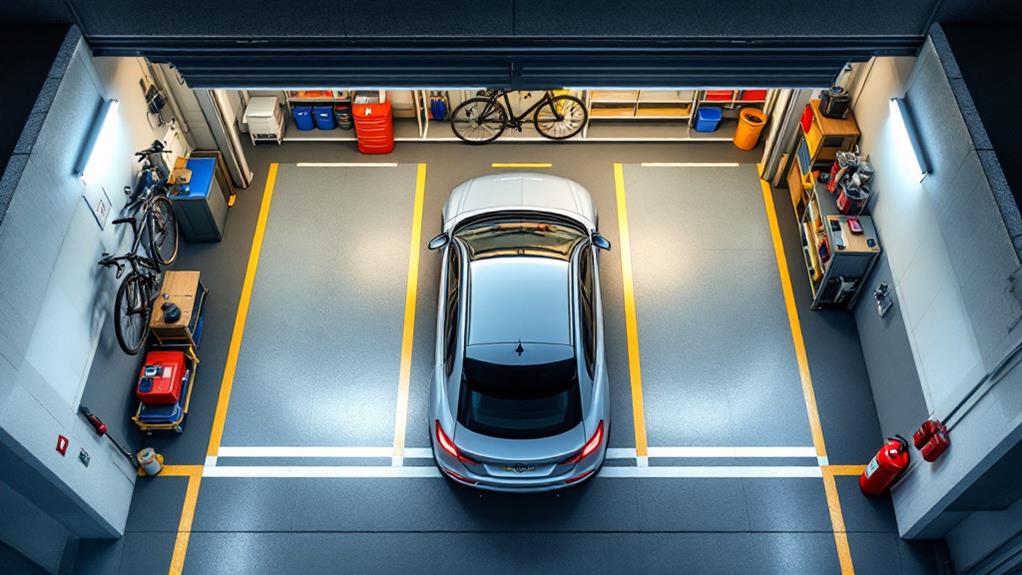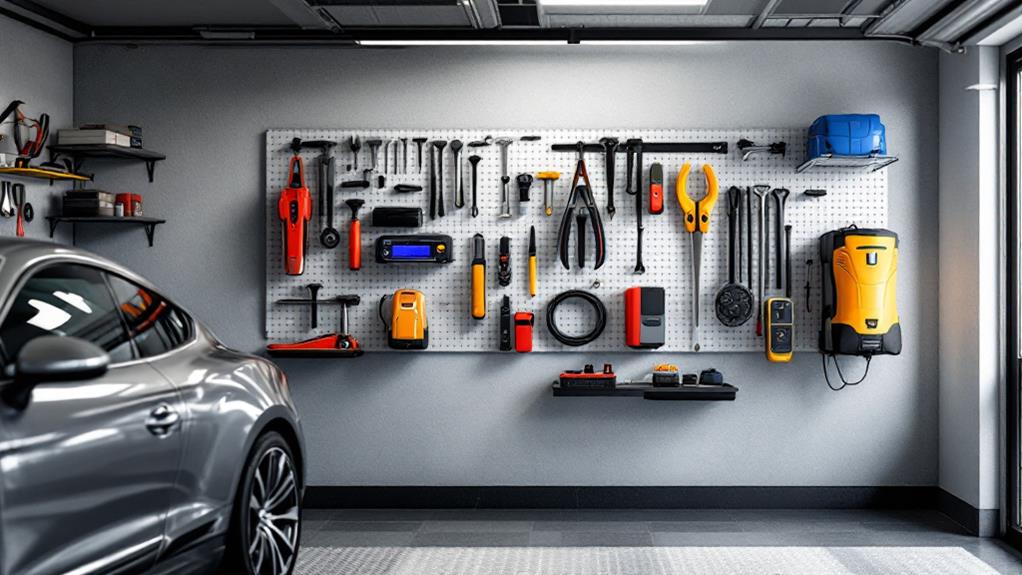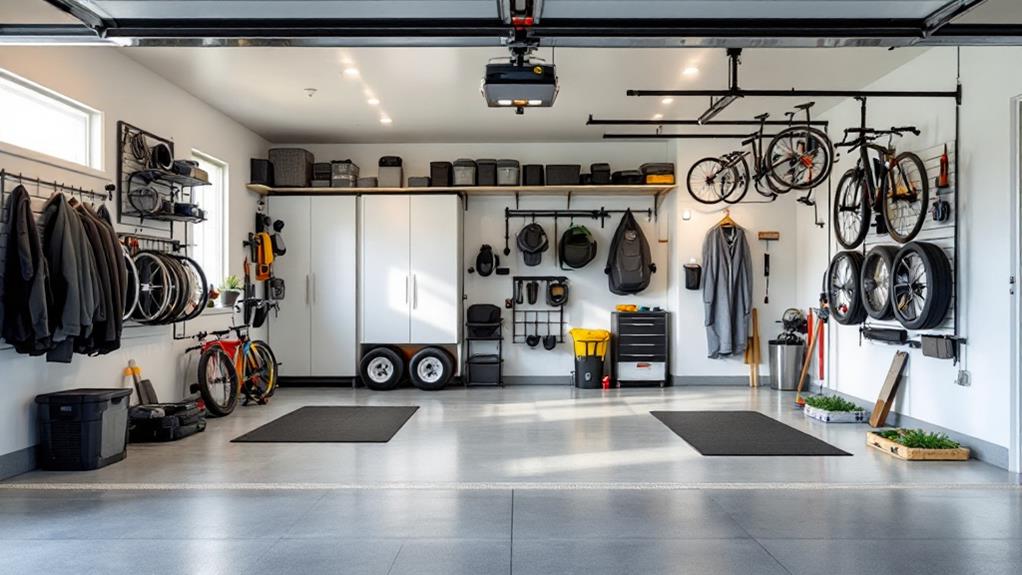How to Winterize Your Home Garage for Car Parking

To winterize your home garage for car parking, start by evaluating its condition and sealing any gaps or cracks. Insulate the walls, ceiling, and garage door to keep the space warm. Install weatherstripping around the door to prevent drafts. Organize and declutter the area to maximize space for your vehicle. Upgrade your lighting system for better visibility during dark winter days. Maintain your heating system and prepare snow removal equipment for easy access. Don't forget to create proper winter storage solutions for your car and tools. By following these steps, you'll guarantee a cozy and efficient garage space throughout the cold season.
Assess Garage Condition
Before you begin winterizing your garage, it's crucial to assess its current condition. Start by inspecting the garage door, as it's the largest opening and a primary source of heat loss. Check for any gaps, cracks, or warping that could compromise its insulation. Test the door's operation to guarantee it opens and closes smoothly, addressing any issues promptly.
Examine the weather stripping around the garage door and any windows. Look for signs of wear, brittleness, or gaps that could let cold air seep in. Replace damaged weather stripping to maintain a tight seal. Inspect the walls, ceiling, and floor for cracks or holes that might allow drafts or moisture to enter. Pay special attention to areas where utilities enter the garage, as these spots are prone to air leaks.
Check the garage's lighting system to ensure proper illumination during darker winter days. Assess your storage solutions and consider reorganizing to maximize space for your car. Finally, look for signs of pest intrusion, such as droppings or nests, which may become more prevalent as creatures seek shelter from the cold. Addressing these issues early will help create a more comfortable and efficient winter parking space for your vehicle.
Seal Gaps and Cracks
Now that you've assessed your garage's condition, it's time to tackle one of the most critical steps in winterizing: sealing gaps and cracks. Your garage's ability to keep out the winter chill depends on how well you address these potential entry points for cold air.
Start by thoroughly inspecting your garage doors, windows, and walls for any openings that could compromise your garage's insulation. Once you've identified these areas, use high-quality caulk or weatherstripping to seal them effectively. Pay special attention to the garage door, ensuring its weatherstripping is in good condition and creates a tight seal when closed.
To further winterize your garage, consider these additional steps:
- Use expanding foam sealant to fill cracks in garage walls and ceiling
- Check for and seal gaps around electrical outlets and plumbing
- Inspect and replace worn weatherstripping on windows
- Apply caulk around window frames to prevent drafts
- Install door sweeps to block air infiltration at the bottom of doors
Insulate Walls and Ceiling
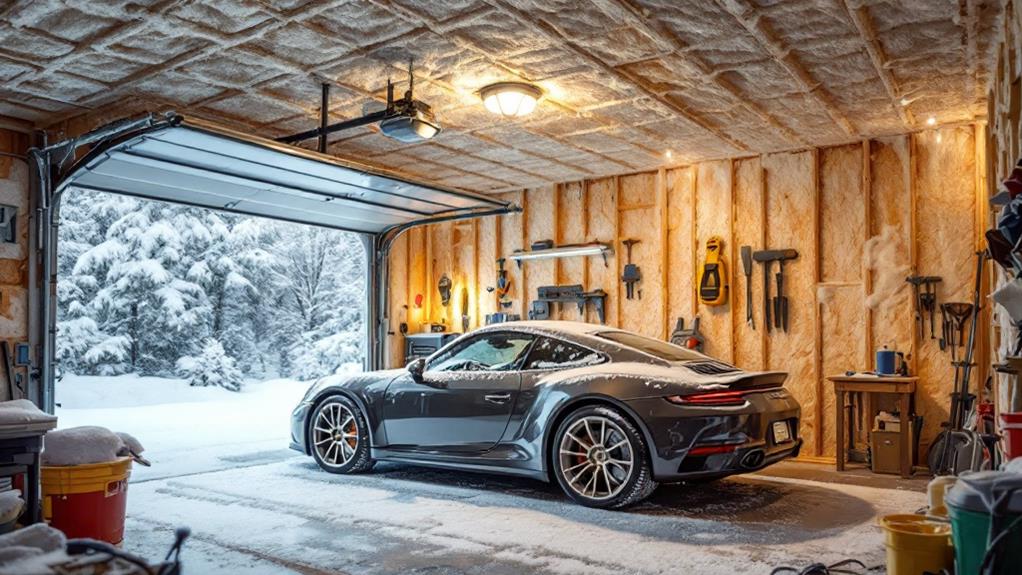
Insulation is the key to maintaining a comfortable temperature in your garage during winter. When winterizing your home, don't overlook your garage space. Proper insulation can greatly reduce heat loss and keep your car protected from extreme cold weather.
Start by insulating the walls with fiberglass batts or foam boards. Measure the spaces between studs and cut the insulation to fit snugly. For added efficiency, consider using a vapor barrier to prevent moisture buildup. Next, focus on the ceiling, especially if you have living space above the garage. Use faced insulation batts or blown-in cellulose for ideal coverage.
Don't forget about the garage door. Install a garage door insulation kit to prevent drafts and heat loss. These kits typically include foam panels that you can easily attach to the door's interior.
For concrete walls, consider applying foam board insulation directly to the surface. Use adhesive and mechanical fasteners to secure it in place. If you're dealing with an unfinished garage, take advantage of the exposed framing to add insulation before installing drywall.
Weatherstrip Garage Door
A critical step in winterizing your garage is weatherstripping the door. This process creates an airtight seal, preventing drafts and keeping your garage space warm. To effectively weatherstrip your garage door, follow these key steps:
- Install high-quality weatherstripping around the door's perimeter
- Replace worn or damaged strips for a tight fit
- Apply caulk or expanding foam to seal gaps in the frame
- Choose durable materials resistant to weather exposure
- Regularly inspect and maintain the weatherstripping
By properly sealing your garage door, you'll not only improve energy efficiency but also protect your garage floor from moisture and cold air infiltration. This is especially important if you're parking your car on the garage floor during winter months.
When selecting weatherstripping materials, opt for those designed to withstand extreme temperatures and frequent use. Rubber, vinyl, or brush-style weatherstripping are popular choices for their durability and effectiveness.
Don't forget to pay attention to the bottom of the garage door, where it meets the floor. A properly installed threshold seal can prevent water, snow, and debris from entering your garage space, further protecting your vehicle and belongings from winter elements.
Organize and Declutter Space
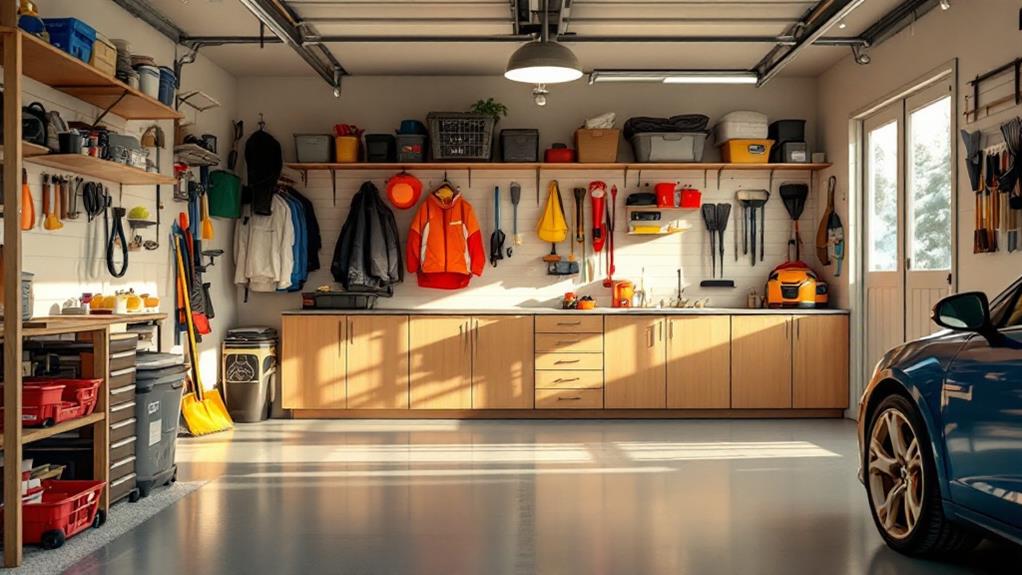
Before the winter chill sets in, organizing and decluttering your garage is essential for efficient car parking. Start by clearing out seasonal items like garden tools and outdoor furniture. This will create more usable space for your vehicle and winter essentials. Next, install vertical storage systems such as shelves, cabinets, and pegboards. These additions will maximize your garage's square footage and keep frequently used items within easy reach.
Don't forget to employ underutilized areas like the ceiling or walls for storing seldom-used items, including sports equipment. This strategy frees up important floor space for your car. Rearrange your garage layout to guarantee easy access to snow removal tools, such as shovels and ice melt. Place floor mats near the entrance to catch snow and slush from your vehicle.
Invest in a garage floor squeegee to quickly remove any accumulated water, preventing damage to your parked car. By implementing these organization strategies, you'll transform your garage into a functional living space that accommodates both your vehicle and winter necessities. With a well-organized garage, you'll be prepared to face the challenges of the cold season while keeping your car protected.
Protect Garage Floor
Protecting your garage floor from the harsh winter elements is imperative for maintaining its integrity and appearance. To get your garage ready for winter, start by sealing any cracks or holes in the floor. This prevents water seepage and damage from melting snow, road salts, and chemicals. To further protect your garage floor, consider applying a durable coating like ENDURACHIP. This creates a protective barrier against winter's harsh elements while enhancing the space's aesthetic appeal.
For those looking to add a splash of color, concrete color staining offers subtle protection while altering your garage's look. If you're feeling bold, a marblized metallic treatment can create a stunning, three-dimensional marbled appearance.
To keep your garage floor in top condition throughout the winter, follow these maintenance tips:
- Regularly sweep and vacuum to remove dirt and debris
- Mop frequently to eliminate salt and chemical residues
- Use doormats to catch snow and salt from car tires
- Install weather stripping to prevent water from seeping in
- Remove snow and ice from your vehicle before parking
Install Proper Lighting

While often overlooked, proper lighting in your garage is essential for wintertime car parking and maintenance. To meet your garage needs, consider upgrading to energy-efficient LED or fluorescent lighting. These options not only improve visibility but also reduce energy costs, making your garage more functional and economical.
Install motion-activated lights to automatically illuminate the space when you enter, conserving energy when the garage is unoccupied. Guarantee the lighting layout provides adequate illumination for tasks like car maintenance and workspace activities. If you're planning to transform your garage into a man cave, proper lighting becomes even more pivotal.
Don't forget to add task lighting over specific areas like workbenches or storage shelves to enhance functionality. Evaluate the overall lighting levels and make adjustments to ensure your garage is well-lit for safe direction and operation during the dark winter months.
If you're unsure about the best lighting solutions for your garage, schedule a free consultation with a lighting expert. They can help you design a lighting plan that meets your specific needs and budget, guaranteeing your garage is ready for winter car parking and maintenance.
Maintain Heating System
A well-maintained heating system is essential for winterizing your garage and ensuring a comfortable environment for your vehicle. To keep your garage warm and cozy during the cold months, you'll want to make sure your heating system is in top shape. It's a good idea to inspect and service your heating unit before winter arrives, whether it's a dedicated space heater or part of your home's central HVAC system.
Consider these steps to maintain your garage's heating system:
- Upgrade to a high-efficiency heating unit for energy savings
- Clear obstructions around vents or radiators for best heat circulation
- Install a programmable thermostat to automate heating schedules
- Insulate walls, ceiling, and doors to minimize heat loss
- Inspect and clean the heating system regularly
Prepare Snow Removal Equipment
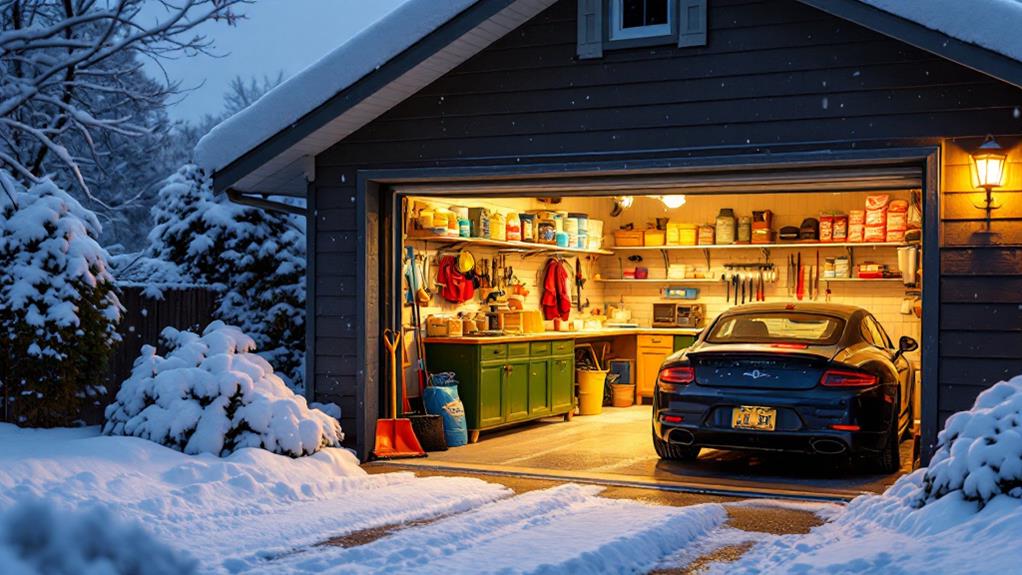
Winter's heavy snowfall can quickly turn your garage entrance into an impassable barrier. To guarantee you can access your garage throughout the season, it's vital to prepare your snow removal equipment before winter sets in. Start by inspecting your snow shovel for any cracks or damage, replacing it if necessary. If you own a snow blower, perform a thorough maintenance check, including changing the oil, spark plug, and fuel filter. Don't forget to stock up on fuel and oil for the machine.
Consider investing in a sturdy ice scraper and snow brush for your car. Keep these tools easily accessible in your garage to help prevent delays when heading out. Salt or ice melt is essential for treating icy patches on your driveway and garage entrance. Store an ample supply in a waterproof container within reach. If you have a steep driveway, consider purchasing traction mats or sand to help your car gain grip in slippery conditions. Finally, organize your snow removal tools in a designated area of your garage, making them readily available when you need them. By preparing your snow removal equipment in advance, you'll be well-equipped to tackle winter's challenges and maintain access to your garage.
Create Winter Storage Solutions
During winter, creating effective storage solutions for your garage can help protect your vehicle and maximize available space. Consider building a dedicated shed or carport for winter car storage, freeing up room inside the garage for other uses. If you're using an uninsulated shed, protect your vehicle with a car cover or bag and use desiccant packs to combat humidity and moisture.
To prepare the shed floor, install a moisture barrier and add gravel to prevent dirt buildup on your vehicle. Don't forget to regularly inspect your stored car and apply protective treatments like fluid film or WD-40 to exposed metal components to prevent corrosion. Park the car on stands to relieve pressure on the suspension and tires during long-term storage, and use laundry dryer sheets to deter rodents.
When storing your vehicle, remember to:
- Disconnect the battery or use a battery tender
- Protect water pipes inside the garage from freezing
- Guarantee proper ventilation to prevent moisture buildup
- Cover any exposed metal surfaces to prevent rust
- Store fluids and chemicals in a temperature-controlled area
